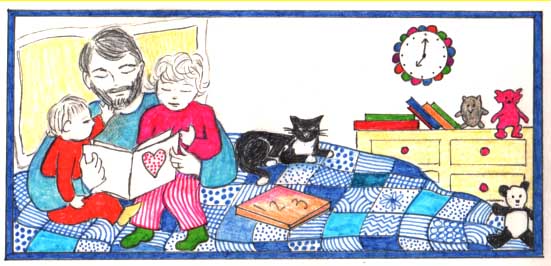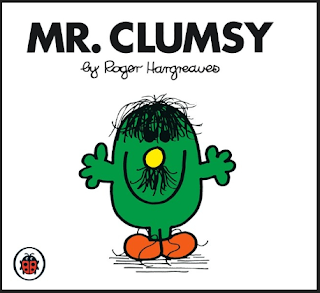Take a look at
the cover of this book. A prim and proper mother rabbit, in a shawl and
billowing dress, stands with twenty-one immaculately dressed little bunnies. The
title is in a traditional-looking cursive script. The background colour is a
pale peach. Everything about it screams “old-fashioned”. When I picked this
book up last year for the first time, I had low expectations. When I saw that
it was published in 1939, I was sure it would be outdated. I could not have
been more wrong. I had made the error of literally judging a book by its cover.
If there is a
more progressive picture book from the 1930s, I haven’t found it. Thirty years
before the women’s movement really gained traction, The Country Bunny and the Little Gold Shoes delivered a remarkable feminist
punch. Thirty years before the Civil Rights Act was signed, The Country Bunny and the Little Gold Shoes needled
away gently at racism and prejudice. And it achieved this without ever feeling
preachy, without seeming like anything other than a lovable Easter story.
The premise is
that every year children are delivered their Easter eggs not by one single
Easter Bunny but by five Easter Bunnies, who are “the five
kindest, and swiftest, and wisest bunnies in the whole wide world”. When one of
the Easter Bunnies grows too old and can no longer run fast, the wise, old and
kind Grandfather Bunny, who lives at the Palace of Easter Eggs, selects a new
bunny to take its place.
The story
surrounds one particular bunny who dreams of growing up to become an Easter
Bunny. Her name is Cottontail, and she is described as “a little country girl
bunny with a brown skin”, and of course she is laughed at by “all of the big
white bunnies who lived in fine houses, and the Jack Rabbits with long legs who
can run so fast”. They tell little Cottontail to go back to the country and eat
a carrot. She grows up, gains a husband, soon has 21 little baby bunnies and is
once again scoffed at.
Then the big white rabbits and the Jacks with long legs laughed and laughed, and they said, “What did we tell you! Only a country rabbit would go and have all those babies. Now take care of them and leave Easter eggs to great big men bunnies like us.” And they went away liking themselves very much.
Cottontail does
indeed stop dreaming of becoming an Easter Bunny, and spends her time raising
her children. When word arrives that one of the five Easter Bunnies has grown
too old and will be replaced, Cottontail is sad because “she thought that now
she was nothing but an old mother bunny”. Still, she gathers her children at
the Palace and they watch the big white Jacks show off their skills to the wise
old Grandfather Bunny. He tells them that while they are pretty and fast, they
have not proven themselves either kind or wise.
But Cottontail
catches his eye, and through a series of questions she proves that she is not
only wise and kind, but also swift enough to chase her 21 children and gather
them quickly together. She is chosen as the new, fifth Easter Bunny, and is set
the most difficult, but most important delivery of all: taking an egg to a sick
little boy who lives far away, across two rivers and three mountains, in a
house on top of the highest peak. In trying to reach the boy, Cottontail proves
herself the bravest of the Easter Bunnies, and the grandfather gives her a pair
of magical gold shoes to help her.
So much about
this book is unexpected for the era. This was the 1930s; once a woman got
married, she stopped working. Once she became a mother, that was doubly it. She
certainly didn’t re-enter the workforce when she still had children. She was probably
discouraged from dreaming too big in the first place. And not only a woman, but
a woman with brown skin? She could definitely not have expected to reach great heights
in the workforce.
What I love
about this book is the way that the characters who show prejudice – the rich
white bunnies, and the male chauvinist Jacks – prove ultimately to be irrelevant.
Sure, they exist, and to some degree they shape Cottontail’s thinking.
Remember, she assumes after having children she is just an old mother bunny. But
the wise old grandfather sees Cottontail for who she is. He is completely open-minded,
and his wisdom and kindness wins out.
And it is not
only the grandfather. When Cottontail joins the other four Easter Bunnies at
the palace, she is welcomed completely and without judgment: “There she stood
in her funny country clothes but none of the other four Easter Bunnies laughed,
for they were wise and kind and knew better”. This little rabbit world is the
way our society could be if our leaders were the very best available: caring,
sympathetic and tolerant. Eighty years later it is a dream that seems more
distant than ever. Wisdom and kindness truly are the most important qualities,
yet are in depressingly short supply.
After reading this
story to Heidi for the first time, I looked up the author, DuBose Heyward, to
find out more about the person behind this enlightened 1930s tale. And I
discovered that he was far more famous as the creator of Porgy and
Bess. While the opera is most associated with George Gershwin, who
wrote the music, it was based on a play by Heyward and his wife Dorothy, which
was in turn adapted from Heyward’s 1925 novel, Porgy.
While Porgy
and Bess has been criticised for racial stereotyping in the decades
since, it was at the time a remarkable production. Set among the
African-American community, it was produced with an entirely African-American
cast – something that was extremely unusual at a time when black roles were
often played by white performers. It was the Heywards (who were white) who
insisted on this back in 1927, when Porgy was first
produced. For context, that was the same year that Al Jolson wore blackface in The Jazz Singer, the first talking picture.
Twelve years
later, with illustrations by Marjorie Flack, Heyward published The Country
Bunny and the Little Gold Shoes, a tale that he told to his daughter
Jenifer, and which was possibly based on a story he had been told by his own
mother. It has never been out of print and has a passionate, cult following,
yet is not as widely known as some other books of the era – for example, Flack’s The Story About Ping.
In 2013, Caroline Kennedy, the daughter of JFK and
Jacqueline Kennedy, described Cottontail as her all-time favourite character. “I
see her now as a woman who re-enters the work force after raising a family — ‘leans
in,’ and does it all — much better than the big Jack Rabbits,” she said. Perhaps
she identified the strength of Cottontail with her own mother following the
death of JFK; it is notable that the country bunny’s husband is never seen or
even mentioned, after the initial statement that “by and by she had a husband”.
It is hard to disagree with Caroline Kennedy's sentiment. This is a story that I will cherish reading to both Heidi and Fletcher over the coming years — and not just at Easter. In an era when so many picture books are meaningless and disposable, it is such a treat to find one with a message so positive. And it was fitting that I made incorrect assumptions when I first saw this story. It is all about how you metaphorically can't judge a book by its cover. And you literally can't judge that by this book's cover.












